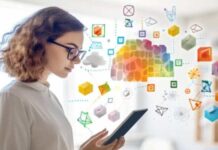
Adaptive learning is revolutionizing the way employees grow and develop their skills at work. Imagine having a training program that feels like it was designed just for you, adapting to your pace, preferences, and unique needs. This isn’t a futuristic concept—it’s happening now, and it’s transforming workplaces into dynamic learning environments.
Adaptive learning leverages data and algorithms to provide personalized learning experiences. Unlike traditional one-size-fits-all training programs, adaptive learning systems adjust content based on the learner’s progress, preferences, and knowledge gaps. This approach ensures that each employee receives the right training at the right time, optimizing learning outcomes and enhancing productivity.
At Bennett, Coleman & Co. Ltd (The Times of India), we personalize training for each individual, emphasizing the growth and development of every employee. Our platforms analyse performance data to identify areas where additional support is needed and provide targeted resources to address these gaps. This tailored approach not only helps employees enhance their skills but also keeps them engaged and motivated throughout their learning journey.
Benefits of Adaptive Learning in the Workplace
The advantages are manifold, making it an invaluable tool for modern organizations.
1. Personalized Learning Paths
Adaptive learning creates personalized learning paths for each employee, catering to their unique needs and learning speeds. This approach helps employees grasp complex concepts more effectively and retain information longer. For example, new hires at BCCL benefit from customized onboarding programs that accelerate their learning curve and integrate them into the company culture more smoothly.
2. Enhanced Engagement and Motivation
When training programs align with individual interests and needs, employees are more likely to stay engaged and motivated. Adaptive learning platforms can offer diverse content formats, such as videos, interactive simulations, and quizzes, which cater to different learning styles. This variety keeps learners interested and makes the learning process more enjoyable. At BCCL, we have observed a significant increase in participation and completion rates for training programs since adopting adaptive learning.
3. Real-Time Feedback and Continuous Improvement
Adaptive learning systems provide real-time feedback, enabling employees to understand their strengths and areas for improvement immediately. This instant feedback loop encourages continuous learning and development. For instance, BCCL’s adaptive learning platform allows employees to take regular assessments, receive instant feedback, and access additional resources to address any deficiencies. This proactive approach ensures that learning is an ongoing process, rather than a one-time event.
4. Cost-Effectiveness
While the initial investment in adaptive learning technology may be significant, the long-term benefits often outweigh the costs. By reducing the time employees spend on irrelevant or redundant training, organizations can achieve higher productivity and efficiency. Additionally, the ability to continuously update and improve training content ensures that employees are always equipped with the latest skills and knowledge.
Implementing Adaptive Learning: Key Considerations
Introducing adaptive learning into the workplace requires careful planning and execution. Some key considerations to ensure a successful implementation include:
1. Assess Organizational Needs
Before implementing, it is crucial to assess the organization’s training needs and objectives. Understanding the skills gaps, learning preferences, and performance goals of employees will help in selecting the right adaptive learning platform and designing effective training programs.
2. Choose the Right Technology
Selecting the appropriate adaptive learning technology is critical to the success of the initiative. Look for platforms that offer robust data analytics, user-friendly interfaces, and customizable content. At BCCL, we chose a platform that integrates seamlessly with our existing HR systems, enabling us to track employee progress and performance effortlessly.
3. Develop Relevant Content
Content is the cornerstone of any learning program. Ensure that the adaptive learning platform is populated with high-quality, relevant content that aligns with the organization’s goals and employees’ needs. Collaborate with subject matter experts to create engaging and informative materials.
4. Encourage a Learning Culture
Fostering a culture that values continuous learning and development is essential for the success of adaptive learning. Encourage employees to take ownership of their learning journeys and provide them with the necessary support and resources. At BCCL, we have cultivated a learning culture by recognizing and rewarding employees who demonstrate a commitment to personal and professional growth.
5. Monitor and Evaluate
Regularly monitor the effectiveness of the adaptive learning program and make necessary adjustments based on feedback and performance data. This ongoing evaluation will help in refining the learning experience and ensuring that it meets the evolving needs of the organization and its employees.
Also Watch: How Gen AI Transforms L&D with Predictive Analytics, Click Here
The future of workplace learning lies in adaptability and personalization. As technology continues to evolve, it will become even more sophisticated, providing organizations with powerful tools to enhance employee development. By embracing this approach, companies can build a more agile, skilled, and motivated workforce, ready to tackle the challenges of tomorrow.
Implementing adaptive learning in the workplace is not just a trend but a strategic imperative. Organizations that invest in personalized, data-driven learning experiences will be better positioned to thrive in the ever-changing business landscape. Whether through onboarding new employees, upskilling existing staff, or preparing for future challenges, adaptive learning offers a path to sustained growth and success.
Note: We are also on WhatsApp, LinkedIn, Google News, and YouTube, to get the latest news updates, Subscribe to our Channels. WhatsApp– Click Here, Google News– Click Here, YouTube – Click Here, and LinkedIn– Click Here.








